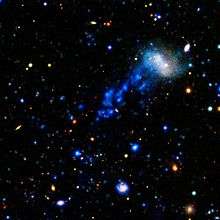IC 3418
| IC 3418 | |
|---|---|
 Composite image of visible and near-ultraviolet | |
| Observation data (J2000 epoch) | |
| Right ascension | 12h 29m 43.919s[1] |
| Declination | +11° 24′ 16.87″[1] |
| Redshift | 0.089598[1] |
| Helio radial velocity | 25,662 km/s[1] |
| Distance | 55 mly (17 mpc)[2] |
| Group or cluster | Virgo Supercluster[3] |
| Characteristics | |
| Type | SBm[1] |
| Apparent size (V) | 1.5 × 1.0′ |
| Other designations | |
| UGC 7630.[1] | |
IC 3418 is a galaxy that is most well noted for its tidal tail, which formed after the galaxy collided with the Virgo Supercluster some 54 million light years from Earth. The galaxy is home to many starburst regions.[3]
The galaxy is thought to be evolving from a dwarf irregular galaxy into a dwarf elliptical galaxy, as the ram pressure of the intracluster medium of the Virgo Cluster through which it is plowing through strips gas from the galaxy, leaving it gas poor, while concentrating the gas in the tidal tail, forming "fireballs" of star formation in its wake.[4]
Within the tail is thought to be the most distant star ever detected, as of 2013, a blue supergiant, SDSS J122952.66+112227.8, illuminating a clump of gas.[5]
References
- 1 2 3 4 5 6 "IC 3418 -- Galaxy in Cluster of Galaxies". SIMBAD. Centre de Données astronomiques de Strasbourg. Retrieved 2011-07-22.
- ↑ Gil de Paz, Armando; et al. (December 2007). "The GALEX Ultraviolet Atlas of Nearby Galaxies". The Astrophysical Journal Supplement Series. 173 (2): 185–255. arXiv:astro-ph/0606440
 . Bibcode:2007ApJS..173..185G. doi:10.1086/516636.
. Bibcode:2007ApJS..173..185G. doi:10.1086/516636. - 1 2 "Astronomers Discover Star-Studded Galaxy Tail". NASA JPL. June 17, 2010. Retrieved 2011-07-22.
- ↑ Eric Gershon (12 June 2013). "Galaxy in its death throes may hold clues to birth of dwarf systems". SpaceDaily.
- ↑ Camille M. Carlisle (12 April 2013). "The Most Distant Star Ever Seen?". Sky and Telescope.
External links
- SpaceDaily, Astronomers Discover Star-Studded Galaxy Tail, 21 June 2010
This article is issued from Wikipedia - version of the 12/18/2015. The text is available under the Creative Commons Attribution/Share Alike but additional terms may apply for the media files.
